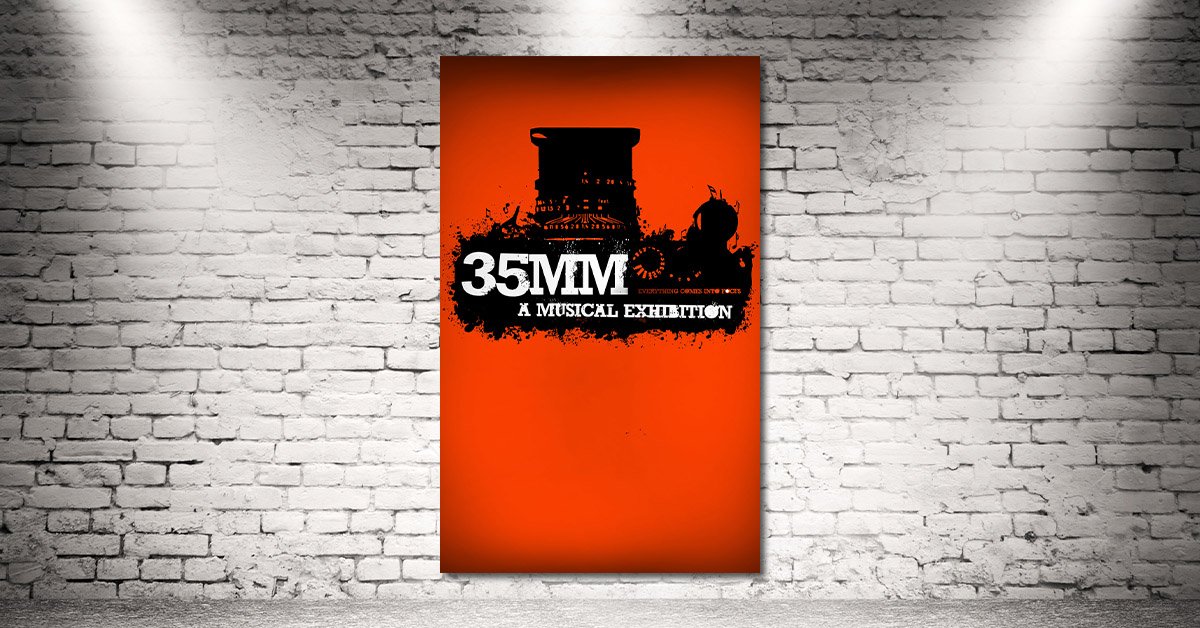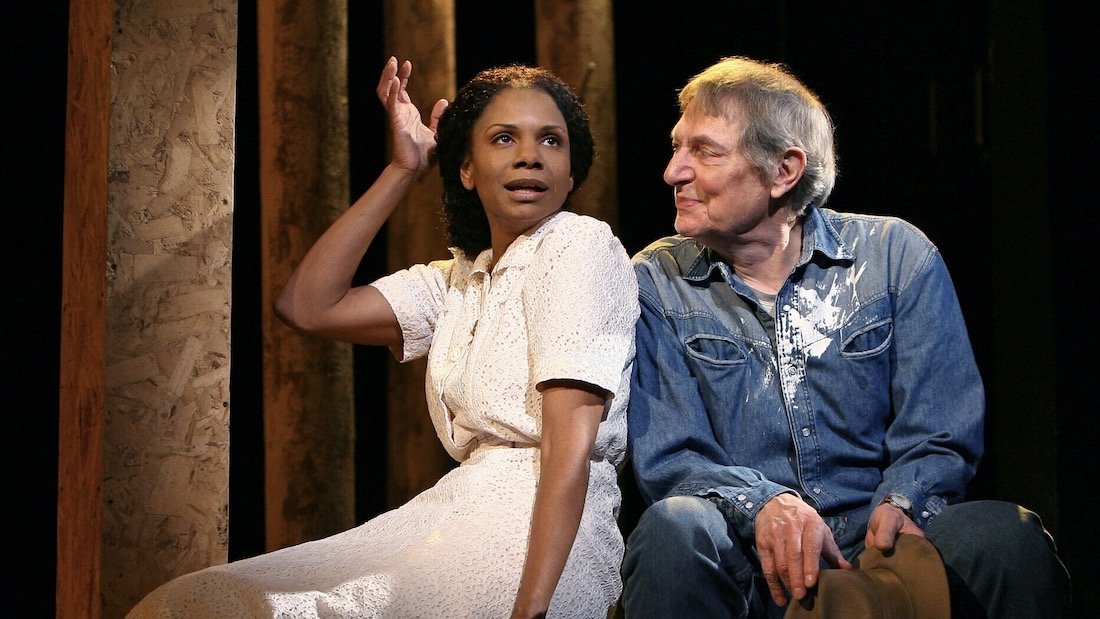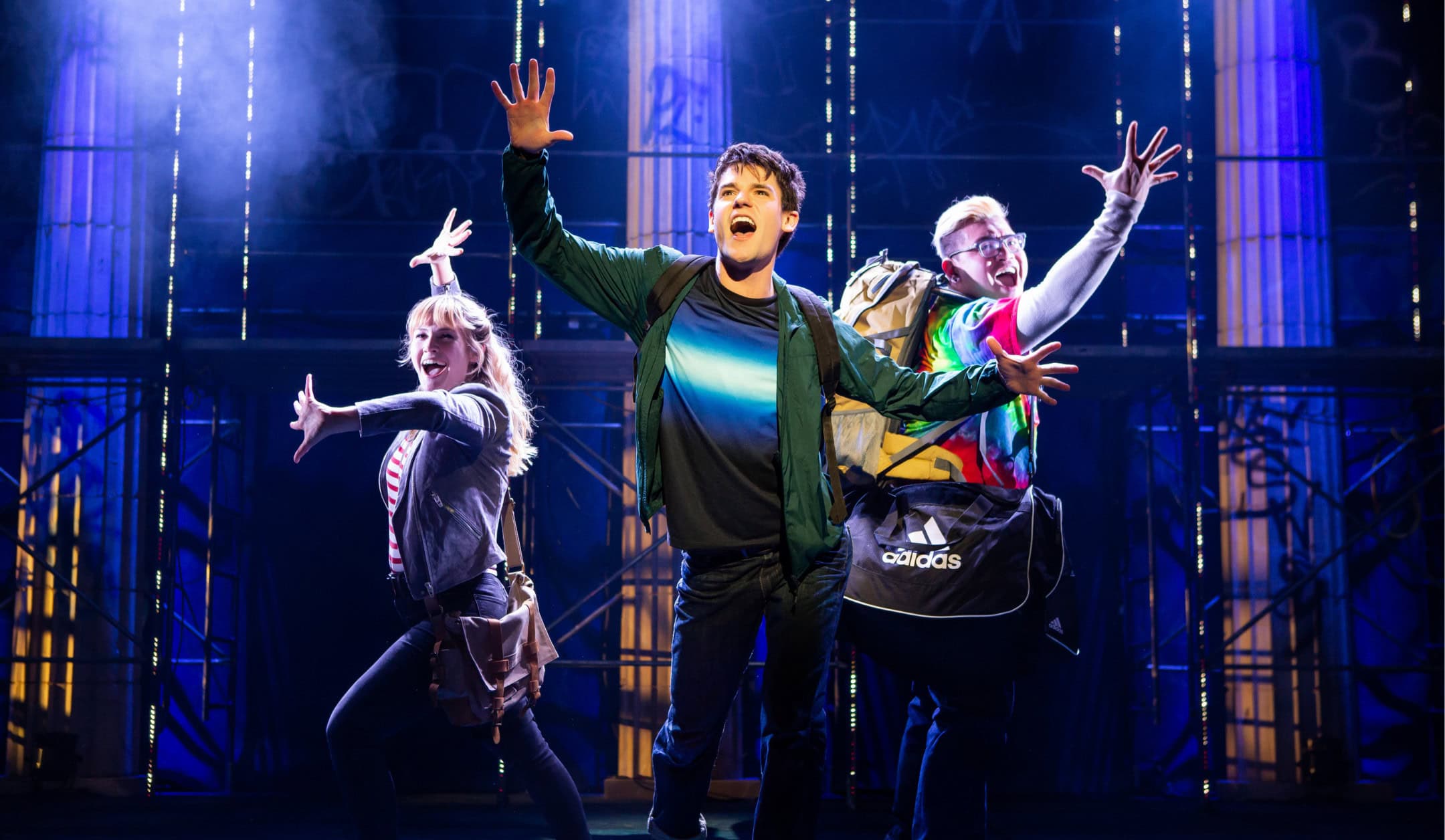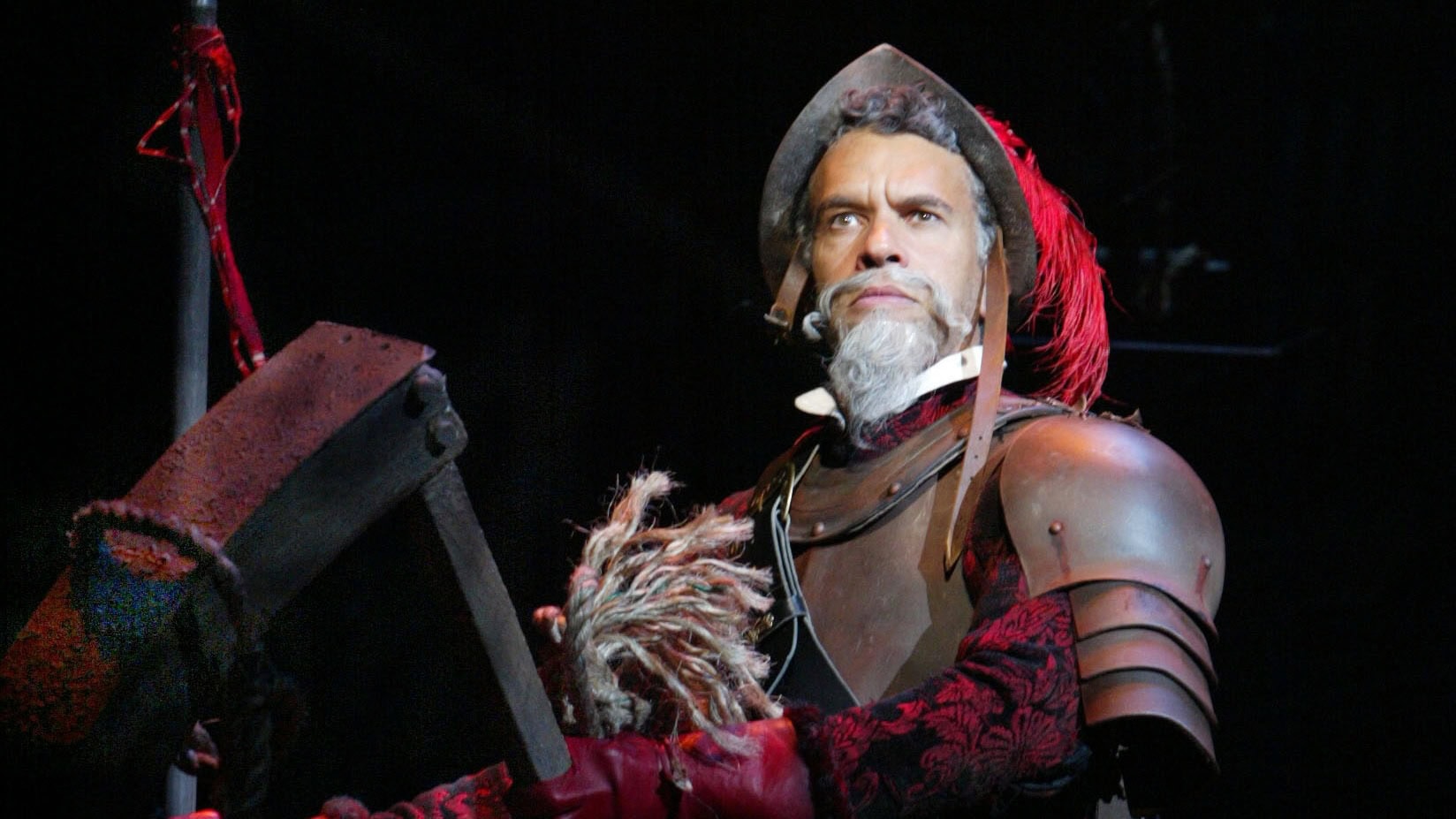
We’re celebrating ten years since the premiere of 35mm: A Musical Exhibition (US/UK) at the Galapagos Art Space in Brooklyn, New York! The electrifying experimental musical is a collaboration between composer Ryan Scott Oliver and photographer Matthew Murphy (many of whose excellent production photos can be found around the Concord Theatricals website). It’s kind of a love story: when they created 35mm, Ryan and Matthew were just beginning to date, and today, they’re married.
Each of a series of photos inspires a self-contained song in 35mm. The musical was created for five performers, but can be adapted to suit a larger cast — check out the casting note on the website for Ryan’s suggestions. There’s also a simplified intermediate version of the show including more accessible vocal arrangements and lowered keys. Digital perusals are available to help you decide if the show is a fit for your group!
For a soundtrack while you read, check out the original cast recording on Spotify. Otherwise, dig into the conversation below, as Ryan dives into the artistic process, multimedia collaboration, the structure of one of the musical’s more epic songs — and much more.
…
How did you get into musical theatre writing? Who are your inspirations?
Around middle school, I was in a production of Once Upon a Mattress (US/UK) and in the back of the script was the vocal line. I became fascinated by sheet music and wanted to understand everything I was seeing! So I taught myself music theory and wrote a few (terrible) songs on a 20-key keyboard I got for Christmas… I put it away until high school (I went to the Los Angeles County High School for the Arts), when we had an Edgar Allan Poe assignment to “use our art” to interpret one of his stories. I wrote a shockingly Sondheim-esque poem (lyric!!) about “The Tell-Tale Heart” and had way too much fun.
By the end of high school, I had begun writing a musical version of The Crucible (hey, don’t laugh! It was actually pretty good!). And that set me off on writing musicals from then on!
For influences, I’d say the ones that have remained with me since the beginning have been, above all, Sondheim (of course!), and opera composers like Britten, Menotti and Barber, and of course theatre writers like LaChiusa, Tesori and Guettel. I also have a great affinity for popular music (all genres), as the fusion of a classical perspective, musical theatre tradition and pop music is where I find music to be most exciting.
Incidentally, it was a full circle moment when 10 years later I had the chance to work with Mattress’s composer, Mary Rodgers!
What was the seed for your concept musical 35mm?
Falling in love with Matthew was the start of the concept! I just wanted to be closer to him and to see how our art could be combined. I was working on two book musicals in development at the time, and was interested in something more abstract that didn’t require so much development hell… I wanted a cast recording, vocal selections and a production, and 35mm seemed to be the quickest way to do that and put myself “on the map” so to speak.
And it’s been a pleasure seeing how embraced the show has been these last 10+ years!
How did Matthew Murphy’s photographs inspire the songs? Did the songs come first, or the photos? Or both?
A combination! Mostly photos before songs, but sometimes songs before photos — and sometimes, photos before songs, and then Matt re-took the photo after!
You’ve stated elsewhere that 35mm is the musical equivalent of a short story collection. Recently, you’ve released Future Demons and Past Demons, musical collaborations with Shirley Jackson, a writer famous for her short story “The Lottery,” among others. How do you create a musical that operates as a collection of stand-alone tales?
I, personally, have always found “musical revues” — especially contemporary ones — to be occasionally tiresome. There’s a pedantic feeling of ordinary life set to song which doesn’t excite me personally. Shirley was always a writer who made the ordinary into the (horrifyingly) extraordinary, and that’s what drew me to her.
As to 35mm, I wanted to transport the audience to these wildly different stories and styles of music. There’s something for everybody, and as we say, I wanted to share the “multitudes” I contained. There’s a connection between it all, however, via darker themes of religion and the supernatural, as well as a connection to queer love which ties it all together.
data-animation-override>
““I wanted to transport the audience to these wildly different stories and styles of music.””
What’s your favorite song off the album? Has it changed since the original production back in 2012?
“Leave Luanne,” easily! It was the first time I got to write what felt like a “short opera” and prove my skill as a storyteller.
In the incredible companion album 35MM: A Musical Exhibition in Focus, you break down the process behind the album on a granular level. It’s a fantastic listen, and I’d recommend it to anyone reading this interview. On the track exploding “Leave Luanne,” you talk about how the song explores a five-act structure. How did you approach this song, and what were the challenges and joys of writing such a long piece?
One of the things about good storytelling is to surprise the audience with what we call a “game changer.” Everything set up at the top is leading to this mid-point, and after the “world” of the story is different, leaving the audience caring but guessing what’s going to happen. In musicals, they occur at the end of Act 1; in most other forms, it’s about 3/5s of the way through.
In “Leave Luanne” for example, you’re set up with the story of an abused woman who needs to escape her husband. Naturally, you assume she will. Because you suspect SOMETHING will happen, and you’re doubtful she’ll lose (and he’ll, say, kill her) — because you’d anticipate that would be a masochistic and horrifying thing for someone to put into the world.
So when the “3rd act” or game changer occurs, and Luanne DOES escape, you suddenly get the feeling that because I’m spending so much time here, that now, something bad is about to happen. You’re kept guessing. And the husband does kill her, and you’re like “What’s gonna happen NOW?” And of course, (spoiler alert) she comes back from the grave to drag her abuser to hell, and others who abuse women.
I don’t think most people suspect that could be a possible ending when the story starts, which is why I think so many people find it to be a strong structure.
Good storytelling, to me, is all about keeping your audience interested AND guessing.
Playbill has mentioned that 35mm has “taken on a life of its own.” The show has been especially popular with school-age theatremakers – what do you think it is about the sound or style of the show that made its cast album basically go viral?
I think there’s truly something for everyone in this. And I think it’s difference from most other contemporary song cycles, and I especially think young people like dangerous things. And 35mm delves into the dark, the surprising, and the dangerous. I didn’t necessarily intend for it to be beloved by the 16-25s, but I was 23-25 when I wrote it, and I wrote it for my taste… and it turns out a lot of people that age share it!
data-animation-override>
““There’s truly something for everyone in this.””
Speaking of the digital life of 35mm – folks have engaged with the musical on platforms like TikTok, and you made the musical available for streaming production during lockdowns. What has the digital life of the show illuminated for you? Have there been any surprising interpretations of any of the songs online?
I’ve definitely seen a lot of super interesting takes on the show and am humbled by how many brilliant ideas people bring to the show that I feel are better than the original.
35mm is truly an ensemble show, with all the company members having a chance to lay down a solo and support another soloist with backing vocals. In the original creation of the show, how did you all approach assigning the different songs and vocal lines to the performers?
I knew Lindsay, Jay and Alex’s voices well and could write to them. Betsy, being the soprano and Ben, being the bass, were easy to write because the other three had to be in middle. And it’s wild because all five of them can kind of do… anything!? I was very lucky.
And I wanted all of them to feel the workload was distributed roughly evenly so it didn’t feel like any one of them was more featured than the other.
Have there been any productions regionally, or at schools or colleges, that have revealed something new about 35mm? Where do you dream of seeing the show happen, if anywhere? Are there any directors you’d like to see interpret the piece?
I will say, there has never been a major run of 35mm in New York city (beyond our original three concert performances). Isn’t that wild? For all its popularity and fame! So maybe someone will encourage a young producer to be the first! I have some great ideas for how to present it…
I have always thought the show would benefit from a fully immersive production in a white-walled art gallery, that begins like you’re walking into a museum and ends blood-spattered, trashed, and having taken on a total life of its own. The audience itself would realize that have become the work of art, and this performance is the only time the work will look exactly like this.
(So I guess I’d love to take a stab at directing it one day!)
Do you have any advice to groups who are putting on your work?
Be creative, subversive, queer, horrifying and shocking!
…
For more Ryan Scott Oliver shows you can perform, visit the Concord Theatricals website in the US or UK. If you can’t get enough of 35mm, check out RSO’s 35mm: A Musical Exhibition in Focus on Spotify, where the composer breaks down each track from the musical.

Plays that Inspired Musicals

QUIZ: Which Character from The Lightning Thief Are You?

